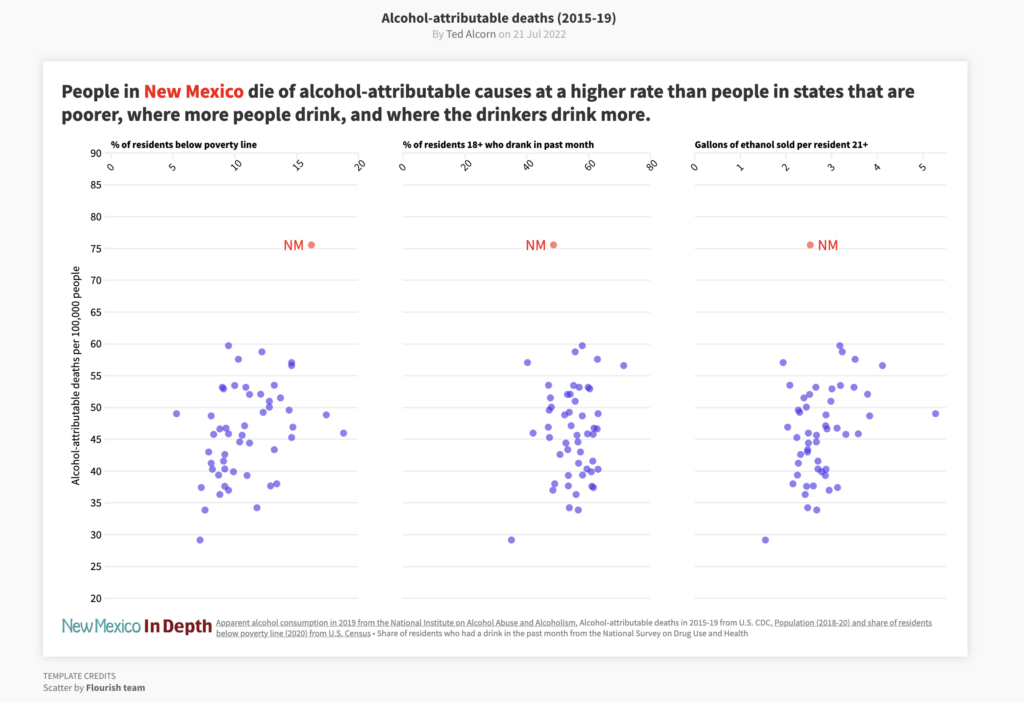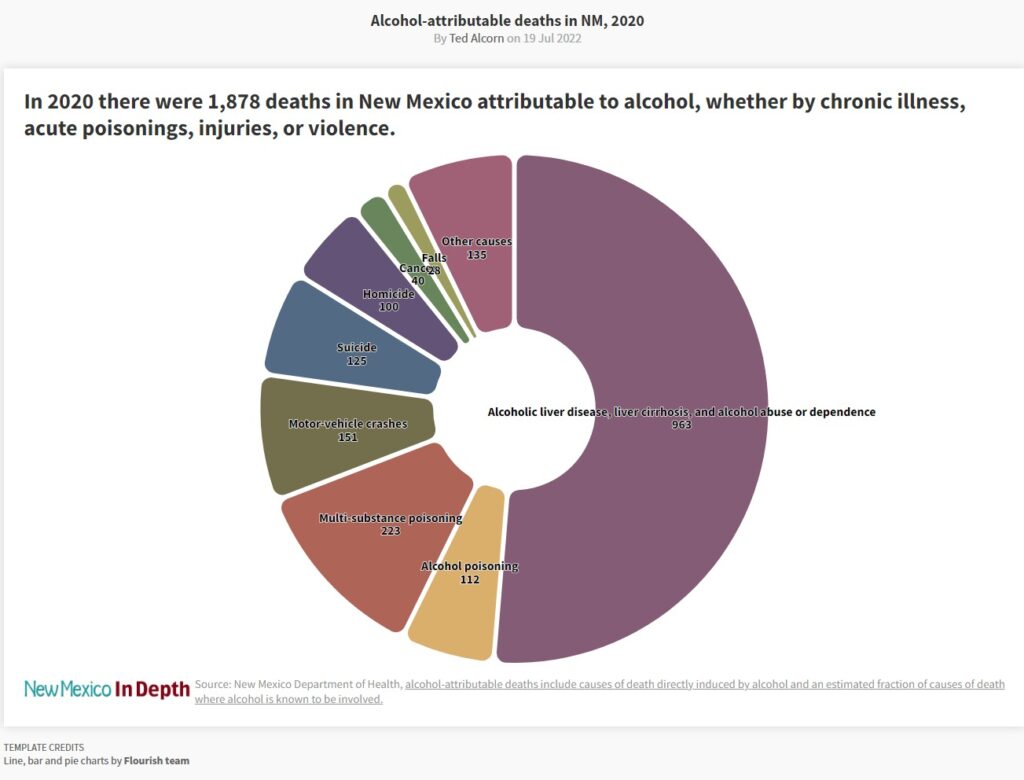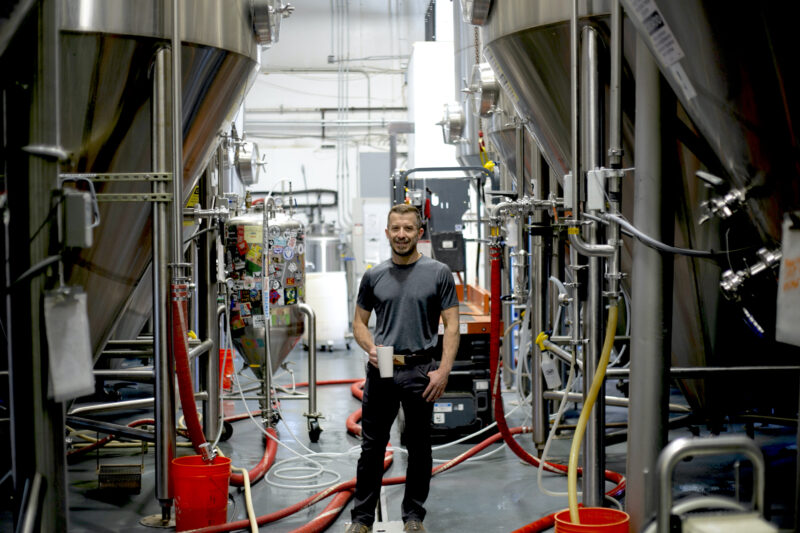By Ted Alcorn/ New Mexico In Depth
Alcohol is killing New Mexicans at a higher rate than anywhere else in the country — yet the state has largely neglected the growing crisis. In this seven-part series from News Port partner New Mexico In Depth, journalist Ted Alcorn investigates the state’s blind spots and shines a light on solutions.
Drinking kills New Mexicans at a far higher rate than anywhere else in the nation, and the crisis is escalating.
Alcohol kills New Mexicans at a higher rate than anywhere else in the country — and no one can fully explain why.
New Mexicans die of alcohol-related causes at nearly three times the national average, higher by far than any other state. Alcohol is involved in more deaths than fentanyl, heroin, and methamphetamines combined. In 2020, it killed more New Mexicans under 65 than Covid-19 did in the first year of the pandemic — all told, 1,878 people.

This outsized harm defies easy explanation. Alcohol kills people in New Mexico at higher rates than in states that are poorer, states where more people drink, and states where the drinkers drink more. “Our risk behaviors do not line up with our deaths,” said Michael Landen, New Mexico’s State Epidemiologist from 2012 to 2020.
This is the first of seven articles that lay bare the damage alcohol does in New Mexico. The series draws on data gathered from a dozen national, state, and local agencies and over 150 interviews, including police officers, clinicians, scientists, lawmakers, brewers, bartenders, liquor store owners, and people struggling in recovery.
The conclusion: alcohol in New Mexico is an emergency hiding in plain sight — and we’ve failed to address the crisis, in part, because we’ve misunderstood it.
We’ve tackled intoxicated driving but overlooked alcohol’s broader harms, in particular its contribution to the state’s high rates of violence and trauma. We’ve assumed alcohol killed mostly Native people when, in fact, Anglos and Hispanics account for the vast majority of the state’s casualties. We’ve heaped blame on inveterate “drunks” when alcohol disorders actually afflict people with a spectrum of drinking behaviors.
And we’ve given up on basic measures governing where and how alcohol is sold that can save lives. Those who profit from selling alcohol have advocated more effectively than people harmed by drinking it. And for decades the Legislature has killed efforts that scientists say can curb excessive alcohol use.
Alcohol poses a thorny political problem because hundreds of thousands of New Mexicans enjoy drinking. It’s woven into everyday life, at weddings and barbecues and communions and sporting events, some of our happiest moments.
Alcohol “transcends generations, centuries, cultures, geography,” said Rep. Antonio “Moe” Maestas, D-Albuquerque, a lawmaker deeply versed in the state’s liquor laws. “It’s one of the most popular commodities — with the highest social cost.”
And that social cost is growing. Over the last two decades, while death rates from heart disease and cancer in New Mexico declined, alcohol-induced deaths more than doubled. One in five deaths of working-age New Mexicans is now attributable to alcohol.
Although the state’s escalating alcohol crisis is complex, it is not unsolvable. While this series doesn’t have all the answers, it raises the most important question for the state to answer collectively:
Have we hit rock-bottom, and are we ready to make a change?

Alcohol’s victims: scattered and shamed
In 2020, the most conspicuous alcohol-involved deaths were the more than 100 New Mexicans killed in crashes on public roadways, and the headline-grabbing victims of 100 drunken homicides. Behind closed doors, another 125 died by suicide with alcohol in their blood. Twenty-eight more drinkers died from falls, and a few more fell asleep outside and never woke up.
But most New Mexicans killed by alcohol died of chronic illnesses in a handful of emergency rooms and intensive care units.
Perhaps no place receives more of these patients than the medical ICU at the University of New Mexico Hospital, the state’s largest. Of its 24 beds, recent medical director Dr. Erik Kraai estimated two to three typically hold someone who wouldn’t be there but for drink — specifically from ethanol, the organic compound common to beer, wine, and liquor.
Although some people believe liquor is more harmful to health, there is no relevant chemical difference between these beverages other than their concentration of ethanol. A standard drink — 12 ounces of beer, a 5-ounce glass of wine, or 1.5 ounces of 80-proof liquor — is interchangeable. And as the number of drinks consumed rises, so do the harms.
Ethanol increases risk of certain cancers and injures the brain in ways not easily distinguished from Alzheimer’s, but the most profound impacts of heavy drinking are on the liver. It can inflame and scar the organ in a process that permanently alters its architecture, resulting in cirrhosis.
As liver function deteriorates, problems cascade. Nearby veins in the esophagus are put under pressure and may rupture and bleed. Toxins that a healthy liver would filter from the bloodstream accumulate, causing delirium and even coma.
In some patients, backed-up fluids flow wherever there is space to expand. In men this may include the scrotum, which can swell to the size of a basketball and become so cumbersome the patient must lie immobile, their legs elevated. Given medications with a laxative effect to help flush their system, too weak to get to the bathroom, these patients often rely on caregivers to clean them and their bedsheets several times a day.
Alcoholic liver disease, cirrhosis, and a constellation of illnesses attributed to alcohol abuse and dependence together killed 963 people in New Mexico in 2020 — a majority of the state’s 1,878 alcohol-related deaths — and drove the growth of its alcohol-related death rate. For example, alcoholic cirrhosis deaths increased four-fold between 1999 and 2020.
Kraai described these deaths as brutal, degrading, and unmercifully prolonged. But patients often lose their grip on their surroundings, he said. “I think it’s often more traumatic for the family.”

These deaths don’t make headlines or provoke legislative action in part because they’re little acknowledged beyond hospital walls.
Viral videos of ice-bucket challenges spread awareness about amyotrophic lateral sclerosis, better known as A.L.S. Cancer survivors proudly run marathons to raise money for research. But people struggling with alcohol-related disease and their families are reluctant to draw attention to it.
“Shame is one of the biggest obstacles,” said Angie Harbin, who struggled vainly to preserve her marriage to a man who couldn’t break his drinking habit. “Shame for the person that has failed yet again, shame for me that I couldn’t fix it.”
The health system itself strains to count alcohol-related deaths. The Centers for Disease Control and Prevention (CDC) classifies deaths as “alcohol-induced” when the cause listed on the death certificate could only be due to drinking, such as alcoholic liver disease or acute alcohol poisoning. But that count is incomplete.
In many deaths, alcohol’s role is difficult to distinguish and doctors, coroners, and medical examiners often fail to note it on the death certificate. To provide a more comprehensive measure, the CDC defines a broader set of deaths as “alcohol-attributable” or “alcohol-related,” which includes estimates of the share of deaths like cancer and strokes and falls and hypothermia that involve alcohol. By this measure in New Mexico, total deaths due to alcohol were double its number of “alcohol-induced” deaths.
Scattered across the health system, these deaths are rarely considered together by the public or policymakers, obscuring alcohol’s overall impact, one of several blind-spots that affects New Mexico’s response to the crisis.
Blind-spots
This series will examine and debunk commonly held but mistaken notions about New Mexico’s relationship with alcohol.
The first concerns one of our greatest successes: reducing intoxicated driving.
No harm caused by alcohol has received more attention — and with reason: in the early 1990s the state’s rate of fatal DWI crashes was 70% higher than the nation’s. Then, a tragic Christmas Eve crash shocked New Mexicans and their leaders into taking action. The state summoned a whole-of-government response and made New Mexico’s roads safer. But today, DWI has overshadowed the state’s larger problem of alcohol-related deaths, 90% of which have nothing to do with traffic crashes, and a focus on drivers has hampered addressing those broader harms.

In contrast, the relationship between alcohol and violence is overlooked. New Mexico has among the highest rates of homicide, suicide, and child abuse and neglect in the country, and alcohol plays a bigger role than many public safety officials realize.
Of people who die violently in New Mexico, 30% to 40% have alcohol in their blood, according to a New Mexico In Depth analysis of toxicology data — a finding one sheriff called “alarming.” Yet earlier this year when Gov. Michelle Lujan Grisham and Albuquerque Mayor Tim Keller publicly prioritized violent crime, neither connected that violence to alcohol.
Perhaps the most pernicious myth about New Mexico’s alcohol problem is that it mostly affects Native people.
Native Americans in New Mexico do die of alcohol-induced causes at four times the statewide rate, but Anglo and Hispanic people also have vastly elevated death rates compared to their peers elsewhere, and together account for 80% of residents killed by alcohol. If Native people are removed from the data, New Mexico still experiences a higher rate of alcohol-induced deaths than any other state.
Some also falsely ascribe alcohol’s impact on Native people to a genetic predisposition or a cultural propensity for drinking without scientific evidence to back up that belief — and that deflects attention from the true underlying causes of alcohol misuse by Native people. In fact, a smaller share of Native people report consuming alcohol compared to other groups.
More relevant, experts say, is New Mexico’s history of conquest in which governments stripped tribes of their land, barely funded their basic needs, ripped apart families through the boarding school system, and continue to threaten their languages and culture. “We’re always still targeted,” said Jennifer Nez Denetdale, a professor of American studies at UNM and the first citizen of the Navajo Nation to earn a PhD in the field of history. “There’s always still something of value to be taken.”
There’s another group that attracts an unwarranted share of the blame: inveterate drinkers. Dividing the population into drunks and responsible drinkers conveniently allows most everyone else off the hook but scientists no longer view addiction in this black-and-white way.
Alcohol disorders emerge earlier and among far more people than generally believed, particularly in New Mexico. On surveys about substance use, one in four residents who had a drink in the previous month reports difficulty controlling their drinking despite adverse consequences on their lives, among the highest share of any state.
Many would benefit from counseling during routine medical visits to simply reduce their drinking — yet primary care doctors rarely provide this basic service or FDA-approved medications to counter their cravings. More people in New Mexico need and are failing to receive treatment for dependence on alcohol — 73,000, according to the Legislative Finance Committee — than all other substances combined.
Hanging over all this is the misconception that the state can only react to the consequences of alcohol after the fact rather than preventing them through policies that change how people drink. There is strong evidence that certain measures can reduce the hazardousness of alcohol: maintaining limits on days and hours of sale, regulating the number of alcohol outlets, and, above all, increasing the price of alcohol by raising taxes. The Community Preventive Services Task Force, an independent government panel of scientific experts, has reviewed and endorsed all these policies.
Yet according to the New Mexico Department of Health, on the majority of these measures, the state “needs improvement” or is moving in the wrong direction.
Paying the tab
Reversing the state’s surging alcohol-related death rate will require statewide action, but that first means ending the political paralysis that’s brought us to today.
How is it that the state with the highest rate of alcohol-related deaths in the country gives little attention to the problem?
“It’s not like everybody is in agreement about this,” said State Sen. Gerald Ortiz y Pino, D-Albuquerque, a consistent champion for greater public intervention. “We have a serious opponent: there are a lot of people who make a great deal of money from alcohol.”
New Mexico keeps no authoritative account of alcohol sales but based on tax revenues, in 2021 the state’s alcohol distributors sold at least 48 million gallons of beer, cider, wine, and liquor — enough to fill 72 Olympic swimming pools.
Jeff Erway, founder of La Cumbre Brewing Company, said his business had mostly rebounded from pandemic closures.”Honestly, 2021 was a pretty good year for us,” he said, “and 2022 is looking okay.”

Still, despite being the third-largest craft brewer in the state, the 56,000 gallons of beer La Cumbre produced last year was a tiny contribution to the total. Small local breweries and wineries produced a fraction of beer and wine consumed in the state: in 2021 they accounted for 9% and 12% of sales by volume, respectively. Massive global conglomerates like InBev (which owns more than 400 brands of beer including Budweiser and Corona), Diageo (which owns scores of liquor brands), and Molson Coors produced the majority.
By a conservative estimate, 2021’s sales in New Mexico generated more than $1 billion in revenue, which flowed through 2,800 businesses licensed to sell alcohol: bars and restaurants and liquor stores as well as gas stations and supermarkets and even ski areas.
These interests routinely argue that any policy changes that limit their alcohol sales will hurt the state’s economy. A bold statement for an industry that accounts for just one of every 500 jobs in the state, according to a quarterly census from the U.S. Bureau of Labor Statistics, which found brewers, wineries, and liquor stores in New Mexico directly employed about 1,400 people.
Alcohol trade associations argued their economic impact is much broader, estimating that the wine industry contributed more than $370 million to the state economy in 2020 and beer manufacture and distribution contributed $1.6 billion.
But that accounting leaves out damages caused by consuming alcohol. In 2010, the CDC estimated that drinking imposed $2.23 billion in costs on the state of New Mexico ($2.9 billion in today’s dollars), a higher cost-per-drink than in any other state. That estimate includes years of productive labor that alcohol sapped from the state’s workforce, property destroyed in alcohol-involved crashes, healthcare expenses attributable to drinking, and salaries of cops and prosecutors handling alcohol-fueled crimes.
Since that analysis, the state’s alcohol-induced death rate has more than doubled. If the price tag has grown in proportion, alcohol now costs the state more than $6 billion per year, dwarfing the economic impact of businesses that profit from alcohol. For comparison, booming oil and gas production yielded $5.3 billion for New Mexico’s state and local governments in 2021, according to that industry.
Philip Cook, a professor emeritus of economics at Duke University and one of the country’s foremost experts on alcohol policy, said New Mexican taxpayers who do not consume alcohol are paying the tab for those who do. “We’re subsidizing people to drink by taking those costs and moving them from the drinker to the insurance companies […] and to public agencies that have to pick up the pieces.”
The politics of change
At best, New Mexico’s leaders have tried and failed to address the problem. Most have ignored it and a few have abetted it.
Landen, who worked to draw attention to alcohol-related deaths during his years in the health department, said governors of both political parties viewed preventive measures as “a nonstarter.” When he published scientific research about alcohol, he was pressured to soften his language, he said. “You would have to mince words about what were effective interventions.”
Mack Sewell, who served in four administrations as state epidemiologist from 1989 to 2012, said he recommended measures to reduce alcohol access on multiple occasions and each time they were squelched. “I don’t know how to say it in a delicate way: It was not popular.”
Jim Roeber, the health department’s alcohol epidemiologist from 2004 to 2013, credited the state for its effective work addressing DWI but said the growing number of alcohol-related deaths signaled that it’s time for a change in strategy. “Whatever we’re doing, it’s just not enough. We need more and a different type of focus.”
It’s unclear if politicians will take heed.
Gov. Michelle Lujan Grisham has supported measures that increase access to alcohol.
Reforms to the state’s laws that she pressed for in 2021 made it easier for restaurants to acquire licenses to sell liquor. The final legislation also allowed existing license holders to deliver alcohol to consumers at home, and eliminated some of the remaining restrictions on sales on Sundays and Christmas Day, among other changes.
In a statement to New Mexico In Depth, the governor’s office defended the measure, saying it “included numerous safeguards” such as limits on the volume of alcohol dispensed and the locations where it could be delivered, and required the health department to study the law’s effects.
Most important of all, the state’s alcohol taxes —which public health scientists say should be proportional to the true social cost of alcohol—have fallen to their lowest real value in 30 years. A 2017 effort to increase them failed in the Legislature, and former health department staff said the governor hasn’t shown interest in reviving them.
But blame for New Mexico’s inaction doesn’t rest with state leaders alone. Public interest organizations that seek to improve the state’s well-being either have focused on small slices of the larger problem or sat on the sidelines.
A coalition of public health groups and citizens that emerged in 2017 to press for statewide changes in alcohol policy quickly fell apart. The local chapter of Mothers Against Drunk Driving said it confines itself to making the roadways safer. “We don’t normally comment or become involved in alcohol issues, unless it relates to underaged consumption,” wrote regional executive director Lindsey Valdez. Alcohol poses such enveloping problems that no one sees them as their own.
The story is similar nationwide, where alcohol has contributed to more than one million deaths since 2000, part of a rising wave of “deaths of despair” that shrank U.S. life expectancy even before the Covid-19 pandemic. And no state has taken action sufficient to stem its harms.
The largest nationwide non-profit organization devoted to the problem, the Alcohol Policy Alliance, has an annual budget of less than $50,000 and a single paid staff-member.
New Mexicans themselves are largely in the dark about the problem. “People just are not aware of just how much higher New Mexico’s rates are than the national average,” said Roeber. And even after a full accounting of the devastation, change may not seem possible.
We tolerate tens of thousands of inebriated people — including lawmakers — taking to the roads each year. Delayed hospital care for seriously ill patients because beds and staff are occupied by patients there on account of alcohol. Billions of tax dollars spent reacting to harms rather than trying to prevent them.
But Landen says the past is no reason to become discouraged: A further increase in alcohol-related deaths is “not inevitable.” Just as alcohol’s harms have grown over the years, the state needs to make sustained efforts, addressing the problem systematically with state-of-the-art approaches.
Erway, the local brewer, is a proud member of what he described as “the oldest profession on earth,” but in his late 20s he spent five years teaching music at a school in the Navajo Nation. There, where several of his students were orphaned by alcohol, he got deeply exposed to the impacts of drinking.
“It is incredibly awkward to try to balance both your desire for people to enjoy your product — but to enjoy it in a way that is responsible to society and that is not detrimental to their health,” he said.
“I do believe you can have both,” he said, adding, “It can’t be all or nothing.”
Ted Alcorn is a writer raised in New Mexico whose work has appeared in The New York Times, The Atlantic, and The Washington Post Magazine, among other publications. For New Mexico In Depth he’s investigated how the state’s prisons have ignored an epidemic of hepatitis C, how Albuquerque stood up its branch of non-police emergency response, and how non-profit hospitals shortchange community health. Follow him at @tedalcorn
This story was originally published by New Mexico In Depth.